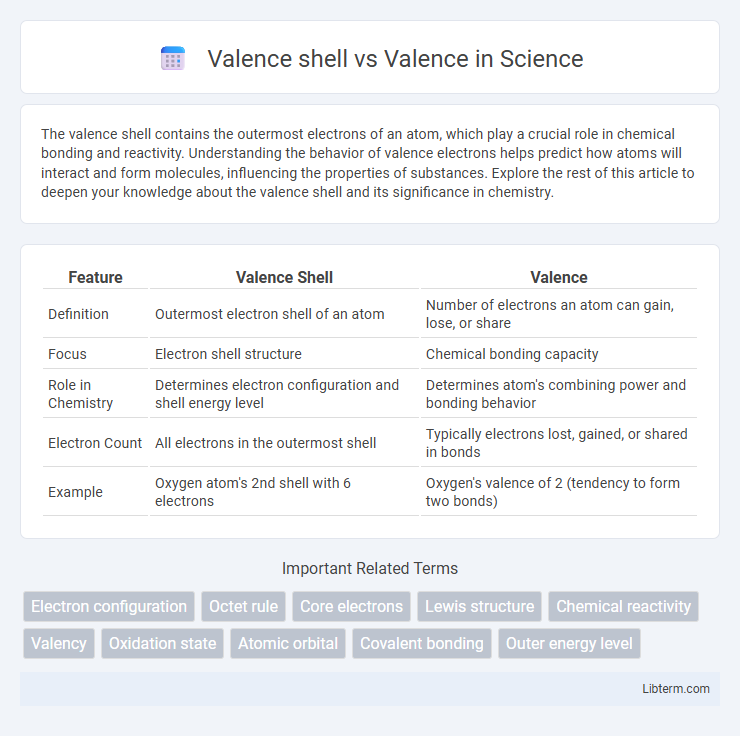The valence shell contains the outermost electrons of an atom, which play a crucial role in chemical bonding and reactivity. Understanding the behavior of valence electrons helps predict how atoms will interact and form molecules, influencing the properties of substances. Explore the rest of this article to deepen your knowledge about the valence shell and its significance in chemistry.
Table of Comparison
| Feature | Valence Shell | Valence |
|---|---|---|
| Definition | Outermost electron shell of an atom | Number of electrons an atom can gain, lose, or share |
| Focus | Electron shell structure | Chemical bonding capacity |
| Role in Chemistry | Determines electron configuration and shell energy level | Determines atom's combining power and bonding behavior |
| Electron Count | All electrons in the outermost shell | Typically electrons lost, gained, or shared in bonds |
| Example | Oxygen atom's 2nd shell with 6 electrons | Oxygen's valence of 2 (tendency to form two bonds) |
Introduction to Valence and Valence Shell
Valence refers to the number of electrons an atom can lose, gain, or share to form chemical bonds, while the valence shell is the outermost electron shell containing these electrons. Understanding valence is crucial for predicting how atoms interact in chemical reactions, whereas the valence shell's electron configuration determines an element's chemical properties and bonding behavior. The distinction between valence and valence shell highlights the relationship between electron arrangement and chemical reactivity in atoms.
Defining Valence: What Does It Mean?
Valence refers to the combining capacity of an atom, indicating the number of chemical bonds it can form with other atoms. The valence shell is the outermost electron shell of an atom, housing valence electrons responsible for chemical reactivity. Understanding valence involves analyzing the valence shell electrons that determine how atoms bond and interact in molecules.
What is a Valence Shell?
The valence shell is the outermost electron shell of an atom, containing valence electrons that determine chemical reactivity and bonding. Valence electrons in this shell participate in forming covalent, ionic, or metallic bonds, influencing the atom's interaction with other elements. Understanding the valence shell is essential for predicting molecular structure and chemical properties.
Key Differences Between Valence and Valence Shell
Valence refers to the number of electrons an atom can gain, lose, or share during chemical bonding, indicating its combining capacity. The valence shell is the outermost electron shell of an atom that contains the valence electrons responsible for chemical reactions. Key differences include valence being a numerical value representing bonding potential, while the valence shell is a physical region in the atom where valence electrons reside.
The Role of Valence Electrons
Valence electrons, located in the outermost valence shell of an atom, determine its chemical properties and reactivity by participating in bond formation. The valence shell contains these electrons, which influence atom stability and interaction with other atoms during chemical reactions. Understanding the behavior of valence electrons is crucial for predicting molecular structure and bonding patterns in chemistry.
Periodic Table Trends: Valence vs Valence Shell
Valence refers to the number of electrons an atom can lose, gain, or share during chemical reactions, while the valence shell is the outermost electron shell containing these valence electrons. In Periodic Table trends, elements in the same group have similar valence electron configurations, determining their chemical reactivity and bonding behavior. Across periods, the valence shell remains the same, but the number of valence electrons increases, influencing atomic size and ionization energy.
Chemical Bonding: Importance of Valence
The valence shell refers to the outermost electron shell of an atom that participates in chemical interactions, while valence denotes the number of electrons available for bonding in that shell. Chemical bonding relies on valence electrons to form stable molecules through ionic, covalent, or metallic bonds. Understanding the valence shell and valence is crucial for predicting bond formation, molecular structure, and reactivity in chemical compounds.
Electron Configuration and the Valence Shell
The valence shell refers to the outermost electron shell of an atom that contains the valence electrons involved in chemical bonding. Electron configuration describes the distribution of electrons across various shells and subshells, highlighting the arrangement in the valence shell which determines an atom's reactivity. The valence shell's electron configuration primarily influences an element's chemical properties and its ability to form bonds.
Real-World Applications: Valence Concepts
Valence shell electrons determine an atom's chemical reactivity, influencing how elements bond to form compounds crucial in pharmaceuticals and materials science. Understanding valence helps design catalysts that accelerate industrial reactions, improving efficiency in producing fuels and plastics. Real-world applications of valence concepts extend to semiconductor technology, where electron configurations control electrical conductivity in devices like transistors and solar cells.
Summary: Comparing Valence and Valence Shell
Valence refers to the number of electrons an atom can gain, lose, or share during chemical bonding, determining its reactivity and bonding capacity. The valence shell is the outermost electron shell of an atom, containing the valence electrons responsible for chemical interactions. Understanding the distinction between valence as a bonding potential and the valence shell as a physical electron layer clarifies atomic behavior and molecular formation.
Valence shell Infographic

 libterm.com
libterm.com